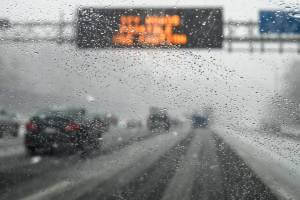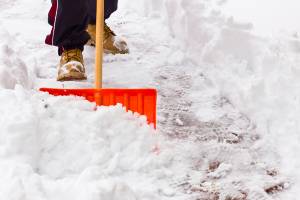Filing a Claim if Your Car Crash Was Caused by Ice or Snow
 As temperatures drop, there is a greater chance of encountering snow and ice on our roads. While it is important to take the necessary precautions to help ensure your safety, crashes can still happen. These collisions have the potential to be very dangerous, particularly when ice is involved because vehicles do not stop as easily in these conditions.
As temperatures drop, there is a greater chance of encountering snow and ice on our roads. While it is important to take the necessary precautions to help ensure your safety, crashes can still happen. These collisions have the potential to be very dangerous, particularly when ice is involved because vehicles do not stop as easily in these conditions.
When a crash happens and snow or ice was a factor, it is only natural to have questions or concerns about how this may impact your ability to seek insurance compensation for injuries and damages.
Will the insurance company claim you are at fault because you were driving too fast? Will the other driver attempt to avoid responsibility for the crash by claiming it was caused by snow or ice?
If you have questions after a car crash, it is important to reach out to a qualified lawyer for assistance. The Bloomington auto accident attorneys of TSR Injury Law have obtained millions in compensation for crash victims and have detailed knowledge of car insurance claims in Minnesota. The initial consultation is free.
What if I Am Partially to Blame for the Crash?
One of the benefits of living in a no-fault state like Minnesota is you can file a claim against your personal injury protection (PIP) coverage no matter who was at fault. PIP may provide compensation for things like medical expenses, lost wages and the cost of replacement services.
However, what happens if your damages exceed the value of your PIP coverage or if you want to pursue a pain and suffering claim against the other party?
Minnesota requires a minimum of $40,000 in PIP coverage. $20,000.00 for wage loss ($500.00 weekly increments) and $20,000.00 for medical. However, even if you purchased more than that, damages from a severe injury could quickly hit your coverage limit. In addition, no matter what happens with the PIP claim, you have the right to pursue a bodily injury claim.
When pursuing a claim against the other driver’s liability insurance policy (for unpaid bills, wage loss or pain and suffering) the at-fault insurance will always blame snow or ice to deflect responsibility. Early investigation by an attorney on your side can often offset these ice and snow defenses. In addition, even if you are partly at fault for the crash, your lawyer may still be able to file a claim because Minnesota law says you can recover compensation if you are less than 51 percent at fault.
Anyone who bears partial fault will see his or her compensation award reduced by the percentage of fault he or she is assigned. That means someone who is 20 percent at fault will see his or her compensation award reduced by 20 percent. Just one more reason to start investigating and documentation collection right away after a crash to avoid any insurance discounts.
Contesting Partial Fault for a Crash
Insurance companies will look for any reason to assign fault for a crash. The presence of snow or ice could be reason enough for them to say you were at least partially to blame. They may say you were speeding, or your tires were old and could not gain enough traction. They could argue their client had no idea there was ice on the road and the crash was “unavoidable” and therefore no one is at fault.
If you can safely collect evidence at the scene, you should try to do so. For example, taking pictures of the damage to both vehicles could be very important. Often, the damage to both vehicles helps to prove how the crash occurred. Listening to what the bad driver says to the police could later help. If the ice defense pops up later but was never said to police that is good evidence.
You may be tempted to admit partial fault for a crash. For example, you think “maybe I was going to fast…” Do not admit anything. The insurance company will take an innocent questionable statement and argue it as a fact. Always tell your attorney your opinions and concerns and let us determine the best way to present them. We simply are trying to prevent the insurance company assigning you a lot more fault than you deserve.
Preparing Your Car for Winter Weather
While it is not possible to prevent every crash, there are things you can do to help ensure your car is safe to drive in winter weather. Taking these steps may also help prevent the insurance company from claiming you are at fault for a crash in icy or snowy conditions.
- Check your tire pressure each week
- Keep an eye on the tread depth of your tires – make sure to replace tires when the treads are too low as they will struggle to gain traction in snow or ice. Best case is to change to winter ties for the cold months and summer tires for the rest.
- Change out your windshield wipers for winter windshield wipers
- Make sure you have enough windshield washer fluid
- Make sure your gas tank is at least half full to prevent moisture from forming in the gas line and freezing
- Slow down in winter weather – this allows you more time to slow down or maneuver away from danger
- Drive defensively – reckless drivers do not change their behavior just because of bad weather
- Make sure your headlights and brake lights work and replace any broken lights or burned out fuses
- Stay off the roads if you are concerned about your safety or your ability to drive safely
- Be cautious on bridges and overpasses, as ice may form more quickly on these surfaces
- Leave more room between the car in front of you than you normally would
- Use your headlights, even during the day, as they may help you find shiny spots on the road that could be ice
TSR is Here to Help. Call to Schedule a Free Consultation
You do not have to go through the legal process alone. You have the option of hiring an attorney to represent your best interests and hold the insurance company accountable for compensating you for damages covered by the policy.
TSR’s experienced legal team has been fighting for crash victims for more than 20 years and has recovered over a billion on behalf of our clients.
Your initial consultation is always free and there is no obligation to take legal action. We also do not charge legal fees unless you receive compensation.
Call today for help and answers to your questions. Ph: (612) TSR-TIME


 One of the most common reasons for a slip and fall accident is a slippery or wet surface. In the late fall and winter months in a state like Minnesota, snow or icy conditions can cause many people to slip and fall.
One of the most common reasons for a slip and fall accident is a slippery or wet surface. In the late fall and winter months in a state like Minnesota, snow or icy conditions can cause many people to slip and fall. One of the scariest things that could happen to any driver is for him or her to suffer a sudden medical emergency, like a heart attack, seizure, stroke or sudden loss of consciousness. Drivers could easily lose all control of the vehicle and get into a life-threatening crash.
One of the scariest things that could happen to any driver is for him or her to suffer a sudden medical emergency, like a heart attack, seizure, stroke or sudden loss of consciousness. Drivers could easily lose all control of the vehicle and get into a life-threatening crash. Sometimes car crashes that do not result in significant damage to your vehicle can cause significant injuries. However, you may not notice symptoms immediately after the crash. In fact, it could take days or weeks before you notice pain symptoms and/or seek treatment.
Sometimes car crashes that do not result in significant damage to your vehicle can cause significant injuries. However, you may not notice symptoms immediately after the crash. In fact, it could take days or weeks before you notice pain symptoms and/or seek treatment.